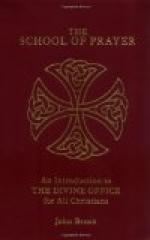The “tables” are to be used thus:—Opening the Breviary at the I Tabella, “Si occurrat eodem die," first find the number marked in that square in which the two feasts in question meet, and then read the direction printed, in column on same page to left-hand side, bearing the same number. For example: the question is about the occurrence of a Sunday of the first class and a Double of the first class. Double of the first class stands first word of page, and Sunday of first class will be found in column beneath the rows of figures. Now the square in which straight lines drawn from double of first class and Sunday of first class meet bears the number 6, and reference to number 6 in column of directions found on same page gives the rule, “Officium de 2, Translatio de I,” that is, the office must be of the Sunday of first class and the double of the first class must be transferred according to the rubrics. When in these brief directive notes, (1-8), mention is made of the “first or the preceding,” the reference is made to feast or office printed in the upper part of the Table, e.g., Double of first class. Reference to “the second” or “following” refers to feast printed in the lower section of the Table. Where O stands in a square in the Tabella it signifies that there can be no occurrence or concurrence between feasts whose “lines” meet in that square. These two tables are very ingeniously arranged. The lists, given in the Breviary following these tables, give the lists of greater Sundays and Ferias, privileged vigils, doubles of first and second class and greater doubles, and tell whether feasts are primary or secondary.
TITLE XII.—THE ARRANGEMENT OF THE OFFICE ACCORDING TO THE RUBRICS GIVEN ABOVE.
If any one wish from the rubrics given in the Breviary to arrange the office, he can see in the calendar and in the tables of movable feasts which office he is to say on the following day. And when he has found out the feast he determines, from the rules given, the vespers and the other hours.
If the office be the office of an excepted feast, the whole office is said from the feast as it is in the Proper or Common of saints; but the psalms of Lauds and the hours are taken from the Sunday psalms, as they stand in the new Psaltery, At Prime the psalm Deus in nomine is said in place of Confitemini. Compline is said from the Sunday psalms. If the office be the ordinary non-excepted office it is recited according to the rule laid down in the new rubrics. Tit. I., n. 5,:—
“Ad matut, invit. Hymnus, Lectiones II. et III. nocturni ac responsoria 2 et 3 nocturnorum propria vel de communi; antiphonae vero, psalmi et versus trium nocturnorum necnon Lestiones I. Nocturni cum suis Responsoriis de feria occurrente...."
"Ad Laudes et ad Vesperas ant. cum Psalm. de Feria; Capit. Hym. Vers. et Antiph. ad Benedictus vel ad magnificat cum oratione aut in Proprio aut de Communi ad Horas minores et Complet. aut cum Psalm semper dicitur de occurrente Feria. Ad Primam pro Lectione breve legitur capit. Nonae ex Proprio, vel de Communi. Ad Tertiam, sextam et Nonam, capit. Respons. breve et orat. pariter sumuntur vel ex Proprio vel de Communi.”




